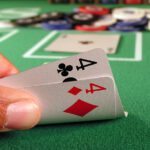Ideally, this is where you should start playing. The levels before this are pretty useless
other than the experience you get by playing the hands. This is where you really need to work on your
strategies and learn to play poker more aggressively. You have the general starting hands down,
but learning to play post-flop is much more important than pre-flop play.
Four post-flop strategies that should be utilized daily:
The Check-Raise
The check-raise is important because in certain situations, you don’t want your opponents to
have odds to call you and draw out on you. Check-raising fixes this problem. Many times you’ll have a
good hand in early position, like AKs for example, and you’ll hit your Ace. However, there are also 2
scare cards that are possible flushes and/or straights. If you bet right out, anyone and everyone
will call you down because they have the correct odds to do so. By checking, you hope for another
player with a worse hand to bet. Then by raising, you give all other players incorrect odds
because they are forced to cold call. Examples can be found on FTR and in SSH. If more than
4 players are in the pot, then check-raising from early position is usually the best play.
If there are less than 4 players in the pot (or you think that it will get checked behind)
then betting is most certainly the correct play.
The Free Card
Taking the free card is dependent on the position you have and the draw you are on.
You can take the free card by raising/betting the flop so people will check around to you on the turn.
Generally, you need to be the last person to act in the hand. It’s cheaper to raise the flop for one small bet and take the free card, than to call the small bet, and call the turn bet. You save one small bet every time. Also, you have the option of folding on the river if you don’t hit the card you are looking for.
Flush draws, open-ended straight draws, and having 2 over-cards like AK are generally what you use
this strategy on. Also, buying the button is important for this strategy to work. If you didn’t force the
button to fold, then you cannot take the free card and must either bet or check/call for your draw.
If many players are calling your bets when you hold a draw, then you should be betting the turn
as well for value.
The free showdown is another option when taking the free card. Generally, it allows you to just
check the river instead of value betting your hand. In a full ring game, however, I prefer the
free card on the turn than the free showdown. This is because most players check-raise on the turn and
if you take the free card then you save yourself bets against a monster hand. Some players, when you
take the free card, will still check to you on the river as well. Thus, if you don’t hit your
hand you may still take a free showdown.
Learning when Not to Fold
Sometimes it is correct to fold, you know you are beat and there is no possible way to win the hand.
However, with numerous people seeing the flop, even the gutshot draw has correct odds to call with a
large pot (for more on odds consult SSH). When the pot gets big, do not fold if you think you can win
the hand with your draw; just make sure you have the correct odds in doing so and you’ll make money in
the long run.
Raising Your Draws
Most small stakes LHE players check their draws and hope to get their cards for cheap.
This is incorrect play. If you have 4-to-a-flush or an open ended straight draw on the flop you
need to jam as much money into that pot as you possibly can. In early position, bet out. Late position,
raise, 3-bet, and even cap with an Ace high flush draw. However, if raising will limit the field,
then be cautious. You want as many people to put as much money into the pot as possible. If raising
will limit the field, then just call. When you hit your flush no one will expect you to have the
flush and you will get even more money out of them. However, slow down on the turn. Generally this is where you take the free card if you are in late position.
If in early position, bet out again as
you force your opponents to make a choice on whether to fold or call. If raised, call for one bet.
Sometimes you can win the pot without hitting your flush. Be happy every time this happens.
If you don’t hit your flush on the river, you can either bet out again hoping your opponents
will fold or you can check/fold. If there are more than 1-2 players calling you down to the river,
it is not a good idea to bet out because the only players that will call you will be the ones that
will have you beat. You will generally hit your flush or straight approximately 1 out of 3 times,
so don’t give up. You will make money in the long run.
One thing to not do: Cold-call. This is a huge leak in many players’ games.
Calling more than one bet to play a hand is not profitable in the long run.
In questionable situations, you either raise or fold. If you don’t think your hand is worth the 3-bet,
then fold. As you become more advanced, you can add in hands to cold-call with, but for now,
stick with none. Acceptable cold calling hands: AJs, KQs, and 99.
Everything below these hands should most likely be folded if raised to you, and everything
above these hands will most certainly require a 3-bet. Also, you need at least 4 other
callers to make a cold call profitable preflop. If less than that, then you should fold.
Submit your review | |










